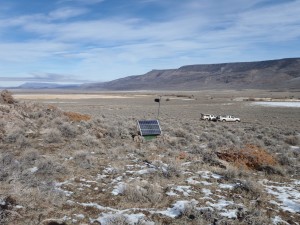Earthquakes shaking things up in Northwest Nevada

Scientists in the UNR Nevada Seismological Laboratory placed additional earthquake sensors in and around the Sheldon Wildlife Refuge. Photo/UNR
The earthquake activity that began in July 2014 in the Sheldon Wildlife Refuge in far northwest Nevada is continuing to shake residents.
UNR seismologists are monitoring the on-going activity that includes three earthquakes larger than magnitude 4.0 since mid-July, including the largest of these, a magnitude 4.6 on July 16.
Since last July, scientists have located 5,610 earthquakes in the swarm.
“A temporary station installed in late November 2014 in the Coleman Canyon area has really helped improve locating events. We estimate that we can only pinpoint about 5 to10 percent of everything we can see on this closest station since the seismic network station coverage is very sparse in northwest Nevada. Sharing several stations with our partner network at the University of Washington has also helped in monitoring the activity,” Ken Smith, seismologist at the UNR’s Nevada Seismological Laboratory, said is a statement.
The swarm has now accounted for 209 magnitude 3 and larger earthquakes, 20 magnitude 4 and larger and five earthquakes of magnitude 4.5 and greater. The largest earthquake was a magnitude 4.7 on Nov. 6, 2014.
Scientists haven’t found direct evidence in the seismic data to indicate the swarm is driven by a volcanic process.
Nevada is the third most seismically active state in the country behind California and Alaska.